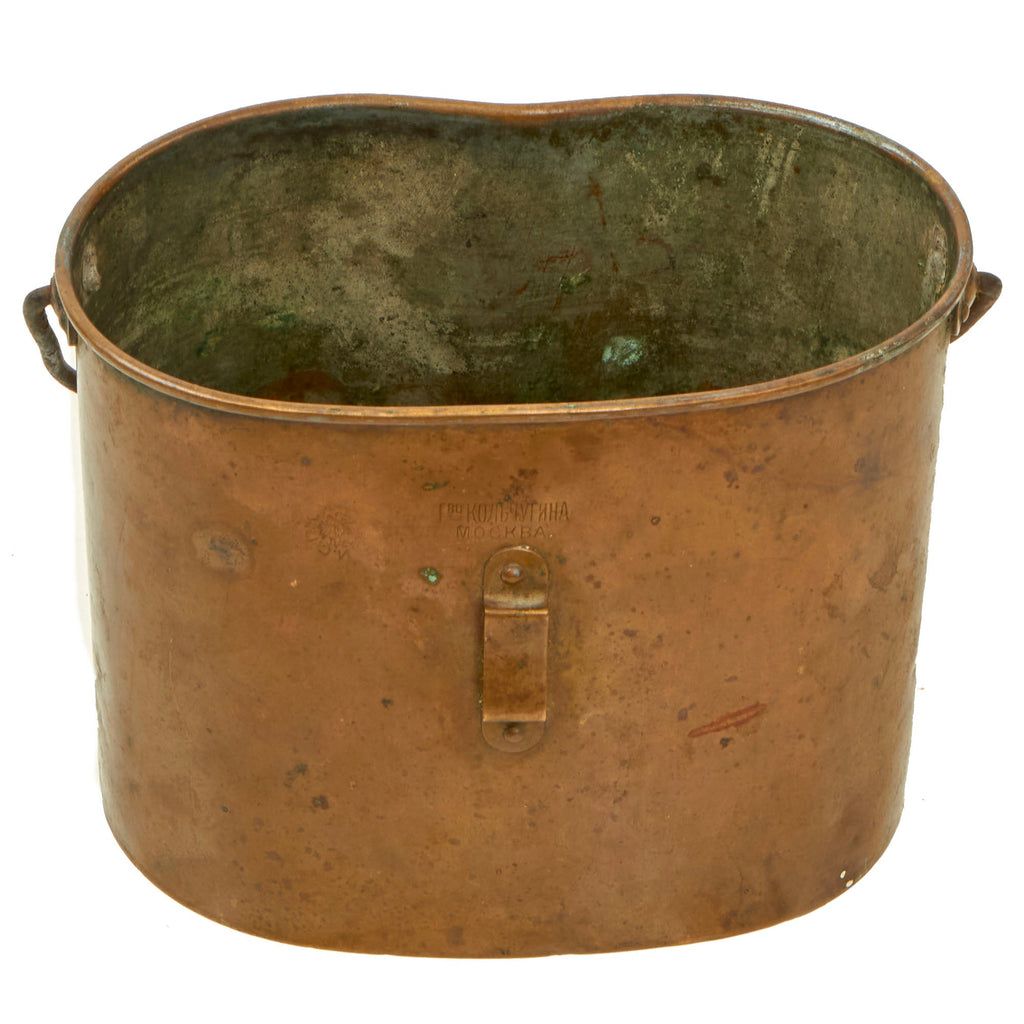Item Description
Original Item: Only One Available. This is a wonderful example of a rather scarce Imperial Russian Army mess kit/cooking pot. This is the standard issue M1909 Mess Tin provided to each Russian soldier in WW1. It was worn at the end of the soldier's blanket "horseshoe roll" and can be seen in numerous period photographs. The Mess Tin is made of copper alloy or brass and retains its original steel handle. The maker mark is still visible on the front of the pot with the name “Koltchugyn” and what appears to be a 1914 date next to the “Russian Eagle”.
A lovely scarce example with minimal denting. Comes more than ready for further research and display.
The Russian Empire gradually entered World War I during the three days before July 28, 1914. This began with Austria-Hungary's declaration of war on Serbia, a Russian ally. Russia sent an ultimatum, via Saint Petersburg, to Vienna, warning Austria-Hungary not to attack Serbia. Following the invasion of Serbia, Russia began to mobilize the reserve army on the border of Austria-Hungary. Consequently, on July 31, Germany demanded Russian demobilization. There was no response, which resulted in the German declaration of war on Russia on the same day (August 1, 1914). Per its war plan, Germany disregarded Russia and moved first against France, declaring war on August 3. Germany sent its main armies through Belgium to surround Paris. The threat to Belgium caused Britain to declare war on Germany on August 4. The Ottoman Empire soon joined the Central Powers and fought Russia along their border.
Historians researching the causes of World War I have emphasized the role of Germany and Austria-Hungary. Scholarly consensus has typically minimized Russian involvement in the outbreak of this mass conflict. Key elements were Russia's defense of Orthodox Serbia, its pan-Slavic roles, its treaty obligations with France, and its concern with protecting its status as a world power. However, historian Sean McMeekin emphasizes Russian plans to expand its empire southward and to seize Constantinople (modern-day Istanbul) as an outlet to the Mediterranean Sea.
Archduke Franz Ferdinand, the heir to the Austro-Hungarian throne, was assassinated by Bosnian Serbs on June 28, 1914, due to Austria-Hungary's annexation of the mainly Slavic province. Though Austria-Hungary couldn't find evidence that the Serbian state had sponsored this assassination, it issued an ultimatum to Serbia during the July Crisis one month later, assuming it would be rejected and thus lead to war. Austria-Hungary deemed Serbia deserving of punishment for the assassination of Archduke Franz Ferdinand. Although Russia had no formal treaty obligation to Serbia, it stressed its desire to control the Balkans, having a long-term perspective toward gaining a military advantage over Germany and Austria-Hungary. Russia was incentivized to delay militarization, and most Russian leaders wanted to avoid war. However, Russia had yielded French support and feared that a failure to defend Serbia would harm Russian credibility, constituting a major political defeat in its goal of controlling the Balkans. Tsar Nicholas II mobilized Russian forces on July 30, 1914, to threaten Austria-Hungary if it invaded Serbia. Historian Christopher Clark believes that the "Russian general mobilization [of July 30] was one of the most momentous decisions of the August crisis". The first general mobilization occurred before the German government declared a state of impending war.
Russia's threats against Germany resulted in military action by German forces, which followed through with its mobilization and a declaration of war on August 1, 1914. At the outset of hostilities, Russian forces led offensives against Germany and Austria-Hungary.
- This product is available for international shipping.
- Eligible for all payments - Visa, Mastercard, Discover, AMEX, Paypal & Sezzle










